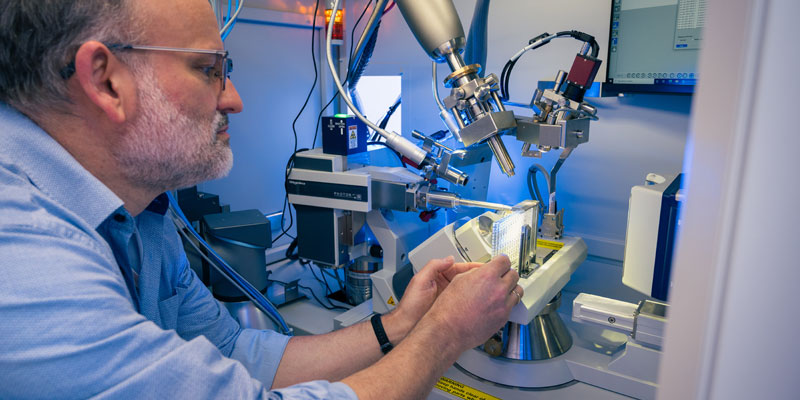
X-ray crystallography
Structural analysis of macromolecules using X-ray crystallography has long been the basis of much of the research in YSBL and the laboratory is well-equipped with crystallisation robots, an automated crystal imager, crystal harvesting tools and in-house diffraction equipment.
In addition, extensive use is made of the Diamond Light Source at Harwell, access to which is through the BAG (Block Allocation Group) mechanism, in collaboration with Newcastle, Durham and Lincoln.
The technique
In a typical research project, the scientist will set up crystallisation screens with their purified protein, normally using the crystallisation robots, and the crystallisation trays will be stored in the crystallisation room or in the automatic crystal imager in the facility.
Any crystals obtained can be harvested and vitrified into cryoloops in the sample preparation labs in a temperature and humidity controlled environment. The cryoloops with crystals are then stored in Dewars, and tested for diffraction quality on the in-house diffraction equipment. Depending on diffraction quality and strength, data can then be either collected in-house or most often at the Diamond synchrotron.
To set up crystallisation experiments, a number of robots are available: a Mosquito, an Oryx and an Oryx Nano. Several format trays are commonly used, including those specifically for in situ diffraction, where X-ray transparency is paramount and the tray is engineered to allow for rotation and transport without undue mixing of reservoir and protein solution.
To assess progress of crystallisation experiments, trays can be housed in the Rigaku Minstrel at either 6° or 20° and imaged at preset intervals. Resulting images can be inspected at the desk. The imager is housed in a dedicated room in order to handle the heat load.
The facility houses a Rigaku XtaLAB Synergy-R ‘flow’ diffractometer. The X-ray source is the PhotonJet-R, a second generation microfocus MicroMax 007HF rotating anode generator with a specialised confocal MaxFlux optic. The XtaLAB Synergy-R system includes a new kappa goniometer with a telescopic two-theta arm to provide total flexibility for the diffraction experiment. The detector is a HyPix-Arc 150° hybrid pixel camera. The curved nature of the detector allows for a higher 2θ coverage in a single image. The Universal Robot automated sample changer allows for unattended screening and data collection. The system is complemented with a Oxford Cryosystems Cryostream for sample cooling.
In addition to diffraction experiments at cryogenic temperatures, the system also comes with a XtalCheck-S attachment for in situ crystallisation plate screening. This allows for automated screening of all wells in a crystallisation tray using X-rays, as well as data collection on crystals of sufficient size and quality.
Data is transferred from Diamond to local storage after each data collection, and made available to users on several Linux boxes, where data can be reprocessed if desired. Backups are done on LTO tapes, and these tapes are also used for archiving. More recently all data is now also archived on Amazon Glacier.
Vitrified crystals in standard Hampton loops can also be screened for external users. In relevant cases, in-house data can be collected when time allows. For details of how to access this service, and associated charging, please contact us using the details on the people pages.